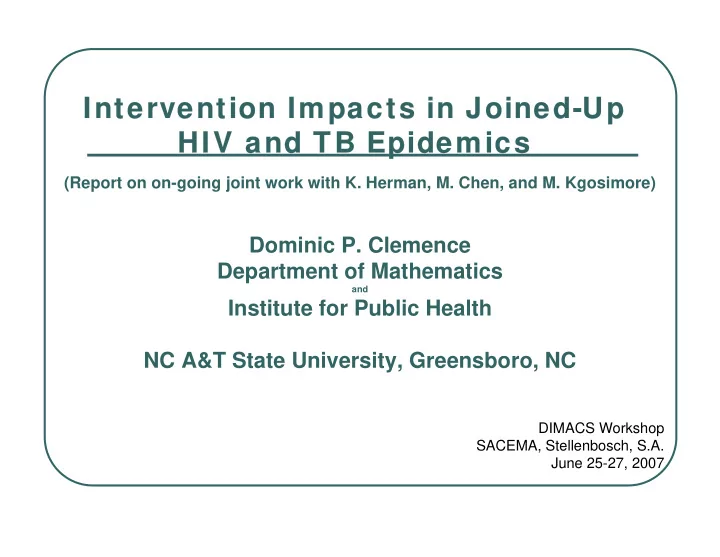

Intervention Impacts in Joined-Up Intervention Impacts in Joined-Up HIV and TB Epidemics HIV and TB Epidemics (Report on on-going joint work with K. Herman, M. Chen, and M. Kgosimore) Dominic P. Clemence Department of Mathematics and Institute for Public Health NC A&T State University, Greensboro, NC DIMACS Workshop SACEMA, Stellenbosch, S.A. June 25-27, 2007
The Problem TB is one of the biggest infectious killers of � PLWHIV, leading up to half of all HIV-related deaths in some places PLWHIV are up to 50 times more likely to � develop TB in their lifetime than HIV-negative people ART reduces the rate of developing TB but PLWH � on HRT still have a massively increased risk of developing TB (4-8 times of HIV-negative) 2006 HIV/TH Report Card for 22 TB High Burden Countries � Ayles (2006): TB finding/TB Prevention in HIV infected populations �
Outline Brief Background Motivation � • Global TB/HIV Epidemiology overview • Interventions Math Model � • Interaction diagram • Equilibria Numerical experiments �
The Global TB Picture The Top 22 Countries accounting for 85% TB Burden – TB Rank
The Global TB/HIV Picture The Top 22 Countries accounting for 85% TB Burden – HIV Rank
The Global TB/HIV Picture Correlation - the sad truth
Summary of Current Situation Summary of Current Situation � Two to three million people around the world die of TB each year � Someone is infected with TB every second � One third of the world population is infected with TB ( the prevalence in the US is 10-15% ) � Twenty two countries in South East Asia and Sub Saharan Africa account for 85% total cases around the world � 70% untreated actively infected individuals die
How HIV fuels the TB Epidemic How HIV fuels the TB Epidemic HIV promotes progression to active TB both in � people with recently acquired and with latent TB HIV is the most powerful known risk factor for � reactivation of latent TB to active disease The annual risk of developing active TB in a PLWH � who is co-infected with TB is 5 – 15%. HIV increases the rate of recurrent TB, which may � be due to either endogenous reactivation or exogenous re-infection. Increasing TB cases in PLWH pose an increased � risk of TB transmission to the general community.
How HIV fuels the TB Epidemic How HIV fuels the TB Epidemic i
Interventions Interventions
Associated Costs
A Mathematical Model A Mathematical Model
A Mathematical Model A Mathematical Model
The Reproduction Numbers The Reproduction Numbers
Endemic Equilibria Endemic Equilibria � Case I and � Case II and � Case III � Case IV � Case V
Endemic Equilibria Endemic Equilibria − ε < ζ ≤ < � (a) (Cases I and III): If and , (1 ) R R R 1 0 0 Hv then and there is a unique endemic equilibrium ζ ≤ − ε > � (b) (Cases II and V): If and , R 1 (1 ) R Hv 0 then there is a unique endemic equilibrium; ζ ≤ − ε ≤ while if and , then there is no (1 ) R R 1 0 Hv endemic equilibrium < ζ < � (c) Case IV: If , then and there are R R 1 0 Hv two endemic equilibria.
Numerical Experiments Numerical Experiments Initial Class Variables Initial Class Variables
Numerical Experiments Numerical Experiments Parameter Val Parameter Values ues
Numerical Experiments Numerical Experiments Typical Class Profiles Typical Class Profiles 1: A 1: AT 1: 3000000 1: 20000000 1 1 1 1: 1500000 1: 10000000 1 1 1 1 1 1: 0 1: 0 0.00 12.50 25.00 37.50 50.00 0.00 12.50 25.00 37.50 50.00 Page 1 Time Page 1 Time A AT 1: PA 1: V 2: PL 1: 1000000 1: 2000000 2: 25000000 1 1 1 2 1: 1000000 2 1 1: 600000 2: 15000000 1 1 2 1 2 1: 0 1 2: 5000000 1: 200000 0.00 12.50 25.00 37.50 50.00 0.00 12.50 25.00 37.50 50.00 Page 1 Time Page 1 Time V and PL PA
Summary Summary ART is (practically) impossible to afford – especially for the � countries most affected – unless something drastic happens Perhaps there is hope: ‘We can start saving lives NOW � through collaborative HIV-TB programmes, strengthening health systems and the research and development of new ways to prevent, diagnose and treat TB among PLWH.’ (According to our model) TB treatment alone, and well as with � HIV incidence reduction, could lower the TB/HIV burden Our model supports the WHO recommendation to “Work � within the HIV community to reduce TB by: • increasing TB treatment – find and treat more cases • reducing latent-to-active prevention’
Acknow ledgements Acknow ledgements � Co-workers: • M. Chen (NC A&T SU) • K. Herman (Emory) • M. Kgosimore (BCA) � Mentors: • A. Gumel (U. Manitoba) • R. Mickens (Clark-Atlanta) � Sponsors • DIMACS, SACEMA, AIMS, NCA&T Math Dept & IPH
Recommend
More recommend